With the recent AI adoption and advancements in communication technologies, automation is now at the core of many operations and processes happening in modern call centers. Quality management is one of them. By automating the entire quality management process, or at least some part of it, call centers can gain many benefits, from improving customer service quality and streamlining quality assurance to preventing costly non-compliance issues that can drain the budget. This article explores automated quality management in detail and how it can transform your call center workflow.
What is Automated Quality Management in Call Centers?
Automated Quality Management (AQM) is the use of AI-driven software tools to automate call center quality assurance and quality management processes. That may include automatic monitoring and evaluation of customer interactions, scoring conversations, assessing agent performance, guiding agent coaching, and ensuring compliance with regulations. Automated quality management systems enable call center managers and supervisors to do all that automatically instead of having to listen to, review, and evaluate each customer interaction manually.
Manual vs. Automated Quality Monitoring
Traditionally, manual quality monitoring has been the standard practice in call centers. Manual quality monitoring relies entirely on human evaluators to review and score a limited sample of customer interactions. This is typically done by reviewing call recordings or monitoring conversations as they are happening through real-time call monitoring.
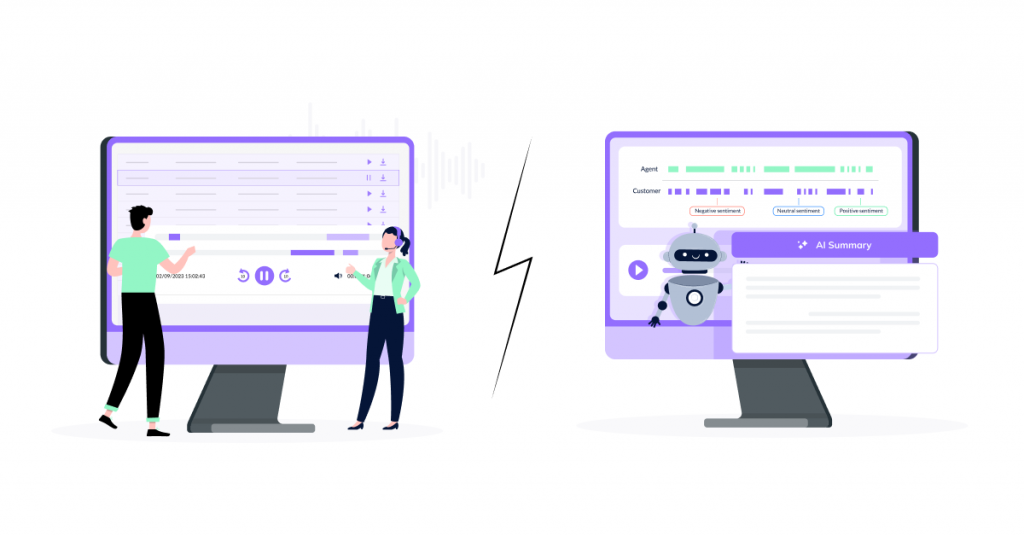
However, with the widespread adoption of Artificial Intelligence in call centers, automated quality monitoring has emerged as a more efficient and cost-effective alternative. Today’s contact center solutions offer a range of tools and features that can automate and optimize this process. Yet, manual quality monitoring still holds value in call center quality assurance.
Let’s now take a look at the short comparison table to better understand the difference between the manual and automated quality monitoring processes in call centers. We’ll outline each aspect in detail in the benefits section.
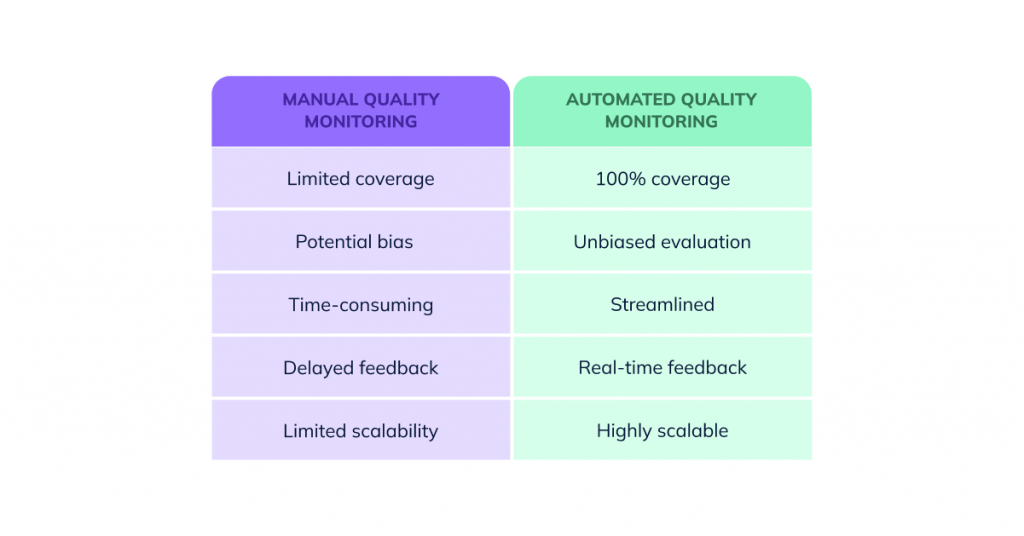
The Importance of AQM for Excellent Customer Service Delivery
In the highly competitive marketplace where competitors are just a few clicks away, providing exceptional customer service has become a necessity for businesses. In fact, according to a Salesforce study, 78% of consumers have made purchase decisions based on the quality of customer service, while 96% say excellent customer service builds trust. And customer expectations are not only high but are continuously on the rise, with more customers demanding consistent and personalized experiences.
By leveraging an automated quality management system, call center managers can stay on top of customer interactions and agent performance and instantly see what stands in the way of delivering consistently high service quality. Based on the insights provided by automated quality management software, managers can make adjustments and improvements on the spot and improve service quality and customer satisfaction.
Benefits of Automated Quality Management
Comprehensive coverage
With manual quality management, managers can normally review only around 2% of the calls that agents handle. It means you can only analyze a small portion of your interactions, potentially missing valuable insights and improvement opportunities.
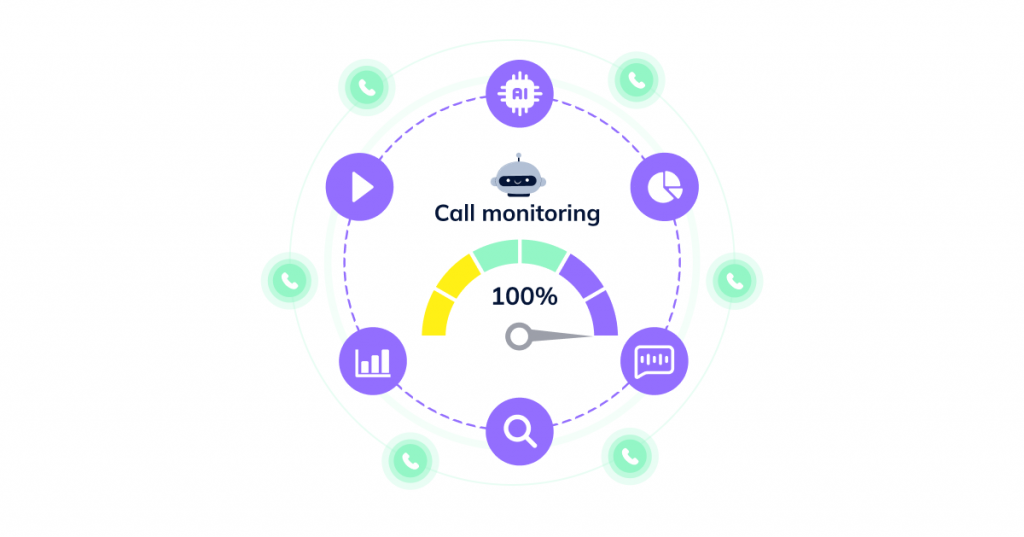
By automating quality assurance processes, you can monitor 100% of your inbound and outbound calls instead of randomly checking a few interactions. That gives managers a deeper and more accurate understanding of how customer interactions are handled and how agents are performing.
Data-driven (unbiased) analysis
When reviewing and analyzing interactions manually, different human evaluators may have varying quality standards and biases, which may ultimately lead to inconsistent scoring. This inconsistency can result in different interpretations of the same interaction, making it challenging for managers to provide unified feedback to agents when assessing their performance. AQM helps you eliminate bias and ensure all customer interactions are evaluated according to the same predefined criteria and quality standards.
Streamlined quality monitoring
Reviewing customer interactions manually is an extremely time-consuming process, requiring evaluators to dedicate a significant amount of their time to listening to call recordings or reading through chat logs. In addition, manual monitoring becomes impractical for call centers handling large call volumes. Automating quality monitoring allows you to streamline the entire process and enables your team to use their time more efficiently so they can focus more on higher-value tasks.
Real-time feedback
With manual quality monitoring, reviews and evaluations are mostly performed after the interaction, meaning managers might be missing an opportunity to provide real-time feedback and coaching to agents. It also means you cannot make immediate improvements.

With automated call quality monitoring, you can monitor the quality of customer interactions in real-time and provide immediate feedback to agents, which also enables you to make quick adjustments.
Increased cost efficiency
Increased cost efficiency is another benefit of implementing an automated quality management process within your call center. With manual monitoring, you can evaluate a very limited number of interactions, while increasing the number of evaluators can add to your total operational expenses. With automated quality monitoring tools, call monitoring and evaluation are done with minimal human involvement, helping you reduce your call center expenses.
High scalability
One more advantage of automated quality monitoring is high scalability. It would be extremely resource-consuming to review interactions manually when your business grows and call volumes increase. With an automated quality monitoring system in place, you can automatically monitor and evaluate customer interactions no matter how high your call volume is.
Better compliance monitoring
AQM can also optimize your compliance monitoring process and help you remain compliant. This is especially critical if you are running a business in a highly regulated industry, and your agents must consistently adhere to scripts, procedures, and compliance standards. With an automated quality monitoring solution, you can instantly spot non-compliant interactions and correct them to mitigate risks and costly penalties associated with non-compliance issues.
Improved agent coaching
Automated Quality Monitoring enables you to easily identify agent knowledge/ skill gaps and training opportunities. Managers and supervisors can use these data-driven insights along with performance KPIs to tailor coaching and training programs to address these specific knowledge or skills gaps rather than providing agents with generic training. That can help you improve your team’s performance.
Increased customer satisfaction
As a result of enhanced agent performance, you can ultimately improve your customer satisfaction levels and customer experience. For example, when your customer service reps are able to resolve customers’ issues quickly and efficiently on the first interaction, that increases your First Call Resolution (FCR) rates and reduces the Average Handle Times (AHT), leading to an increased Customer Satisfaction Scores (CSAT).
Limitations of Automated Quality Management
Limited contextual understanding
Despite the undeniable benefits of using Automated Quality Management solutions, limited contextual understanding is one of its major limitations. While AQM tools can identify specific keywords and phrases, customer sentiments, and trends, they may often fail to comprehend the full context, which can lead to inaccuracy in evaluations or misinterpretation.
Additionally, when evaluating agent performance, AQM systems primarily assess objective metrics like script adherence and the average handle time and are unable to evaluate the agent’s soft skills.
Inability to evaluate complex scenarios
Customer interactions are not always straightforward, especially when it comes to handling complaints, complicated issues, escalations, and frustrated customers. Automated Quality Management tools may struggle to assess the quality of such complex interactions. Evaluating these interactions often requires empathy, human judgment, and more subjective interpretation, which makes the human factor irreplaceable in the call center quality monitoring process.
Features and Capabilities of AQM Software Solutions
Automated Quality Management software solutions may offer a range of features and capabilities. Some of the common ones include:
Speech analytics and AI summaries
When used to analyze customer calls, AQM software tools conduct speech analysis by transcribing customer calls and analyzing customer conversations based on certain predefined criteria.

For example, VoiceSpin’s speech analytics software solution transcribes calls and automatically generates AI post-call summaries that capture the most important aspects of every call and evaluate each interaction based on particular criteria and specific requirements that you set. If you want to know how your agents perform and adhere to scripts and guidelines, you can simply review call summaries without having to listen to the entire recording of each call.
Text analytics
As more call centers are gradually transitioning to multichannel or omnichannel contact centers, many customer interactions are now happening over digital communication channels, such as live chat or social media. A Salesforce study found that 78% of consumers prefer using different channels depending on the context, while 71% have used multiple channels to start and complete a single transaction. In addition to analyzing voice interactions, AQM software may also offer text analytics capabilities, enabling you to evaluate the quality of your text-based interactions.
Interaction scoring
Just like human evaluators would analyze and score each customer interaction manually based on specific criteria, AQM software does that automatically, enabling you to monitor quality across 100% of interactions your customers have with your brand through different communication channels. While some systems will offer predefined evaluation criteria and scoring templates based on standard quality metrics and KPIs, more advanced tools may allow you to set your own scoring criteria.
Keyword spotting
Another valuable feature of AQM systems is keyword spotting, which uses advanced speech analytics technology. It allows you to track specific keywords or phrases, helping you identify trends or patterns in customer behavior and the root causes of issues and complaints. For example, if you track keywords related to customers’ issues with specific product features or functions, you’ll have a deeper understanding of your customers’ needs and expectations as well as the reasons behind their complaints.
Compliance flagging
If your business operates in industries like healthcare or finance, real-time compliance flagging is a must-have feature to look for when selecting an automated quality management solution. Compliance violations can cost businesses hefty fines and penalties, not to mention reputational damage and lost business opportunities. AQM systems that support compliance flagging may be programmed to detect keywords or phrases related to regulatory requirements and notify agents and managers in real time, helping you reduce the risk of compliance violations.
Customer sentiment analysis
Along with scoring customer conversations based on your criteria, you can gain deeper insights into how your customers perceive your products, services, or interactions with your team by tracking customer sentiment. AQM systems can help you do that with sentiment analysis technology. Sentiment analysis uses Natural Language Processing (NLP) and Machine Learning (ML) to determine the sentiment of the speaker based on factors like vocabulary, intonation, pitch variations, loudness, and other variables, which is then given a sentiment score as positive, neutral, or negative. This is an excellent way to gauge customer satisfaction alongside tracking customer feedback through CSAT and NPS (Net Promoter Score) surveys.
Real-time monitoring
One of the most valuable capabilities of automated quality monitoring and management systems is real-time monitoring, enabling you to monitor and evaluate the quality of customer interactions as they occur. When managers are able to monitor conversations as they are happening through real-time alerts, they can react on the fly when specific keywords are being flagged by jumping on live calls and providing on-call guidance to agents via call whispering.
Agent training recommendations
With automated quality management tools, you not only identify agent knowledge gaps and opportunities for continuous improvement that might have otherwise gone unnoticed with manual quality management. AQM solutions empower you with deeper insights by analyzing and evaluating 100% of interactions each agent handles. Beyond that, some solutions can also provide personalized training recommendations, enabling you to deliver highly targeted coaching to your agents.
Book a demo call now to learn more about VoiceSpin’s contact center and speech analytics solutions and how they can help you automate your quality monitoring process while allowing you to deliver excellent customer service and stay compliant.

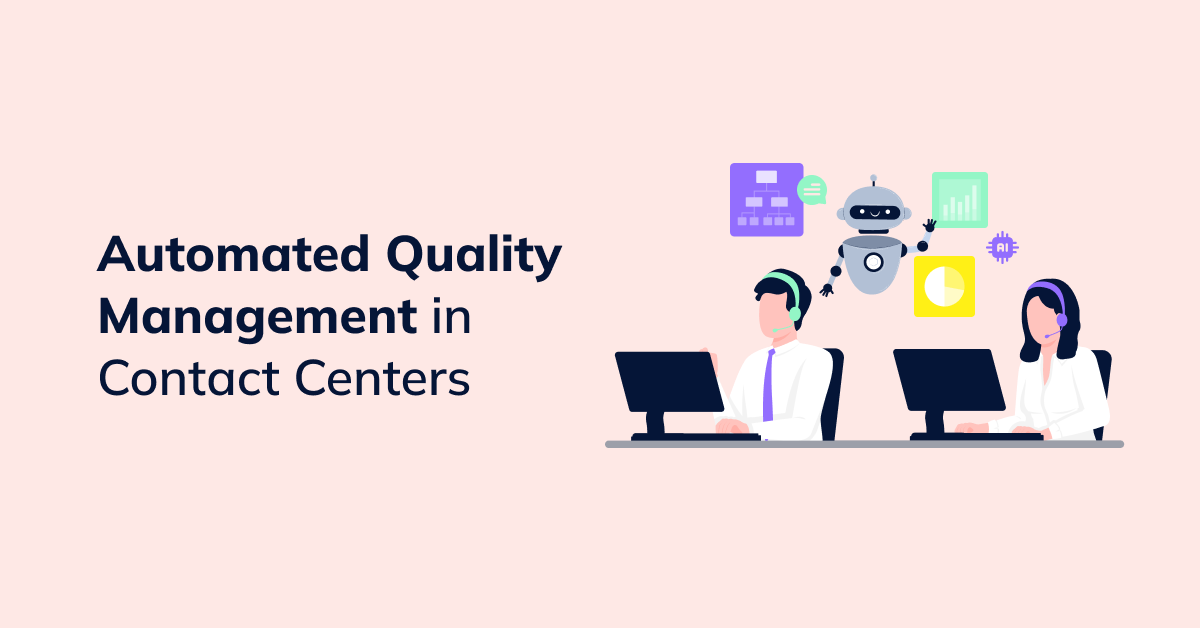

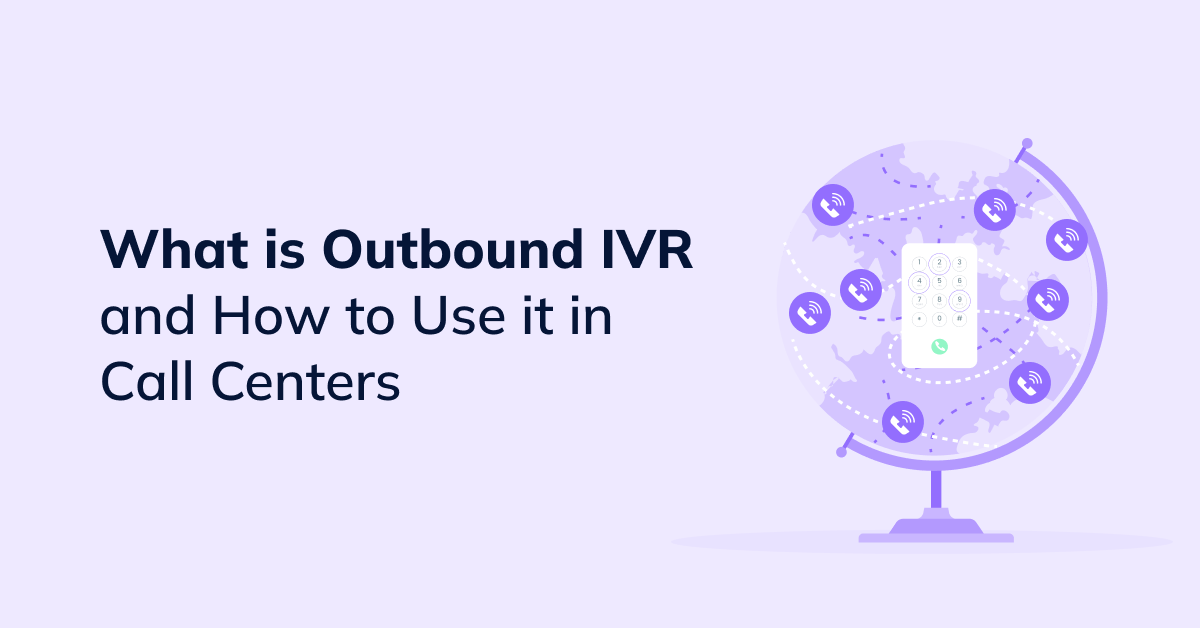
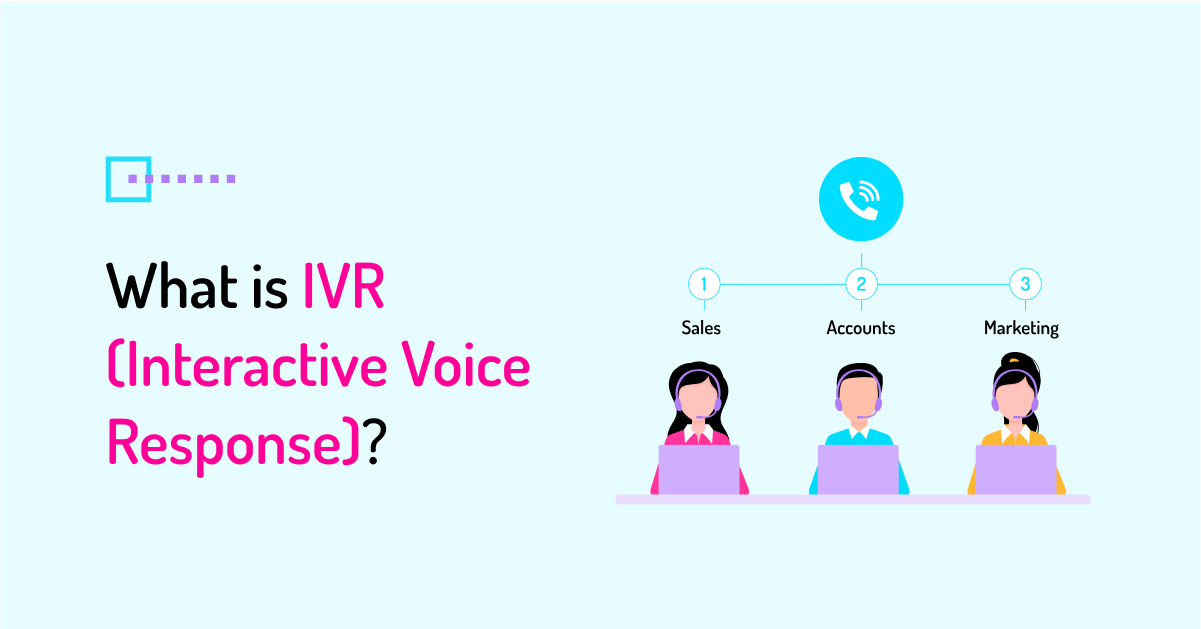
 +18889082995
+18889082995
 +442036084160
+442036084160
 +97237237006
+97237237006